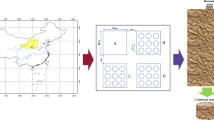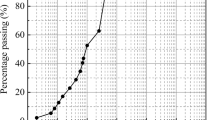Abstract
The engineering importance of compacted loess is now much greater than that of intact loess because of the occurrence of a large number of loess fill slopes and foundations in the last few years. Molding water content (MWC) and degree of compaction (DOC) (or dry density) are two key factors that determine the structure of compacted soil. However, it is not clear how MWC affects the mechanical behavior of compacted loess. In this study, compacted loess specimens were prepared under various compaction conditions to have different MWCs (i.e., 14, 16, 18 and 22%) or DOCs (i.e., 85, 90 and 94%). Unconfined compression tests were performed on these specimens and their counterparts, the effects of MWC and DOC on the mechanical behavior of compacted loess under unconfined condition were interpreted with the assistance of the measured pore-size distribution curves (PSDs), soil–water retention curves (SWRCs) and computed structural parameters. The results show that both MWC and DOC significantly affect the strength-deformation characteristics of compacted loess. When DOC and initial water content are given, the larger the MWC, the larger the unconfined compressive strength (UCS), and the greater the ductility of specimen because of the more uniform distribution of pores and higher suction. At a given MWC, the greater the DOC, the larger the UCS, and the greater the initial stiffness of specimen because of the closer particle arrangement. The initial structural parameter reduces with DOC and increases with MWC, indicating that the soil strength is more susceptible to disturbance from loading or soaking when DOC is smaller or MWC is larger. Consequently, this leads to a higher structure potential for compacted loess. The relationship between the initial structural parameter and UCS is not unique, indicating that the structural difference caused by different particle arrangements may still exist upon soaking, while the UCS of compacted loess grows with the initial structural parameter.












Similar content being viewed by others
Data availability
The data that support the findings of this study are available from the corresponding author, PL, upon reasonable request.
References
ASTM (2013) Annual book of ASTM standards. ASTM International, West Conshohocken
Chen H, Liu MZ, Song ZP (2010) Structural parameters of remolded and undisturbed saturated loess. Chin J Undergr Space Eng 6(03):487–491 (+497. (in Chinese))
Chen CL, Jiang X, Su TZ, Jin J, Li WW (2014) The influence of structure on unconfined compression characteristics of compacted loess. Chin J Rock Mech Eng 33(12):2539–2545 (in Chinese)
Chen HE, Jiang YL, Gao Y, Yuan XQ (2019) Structural characteristics and its influencing factors of typical loess. Bull Eng Geol Environ 78(7):4893–4905
Choobbasti AJ, Kutanaei SS (2017) Microstructure characteristics of cement-stabilized sandy soil using nanosilica. J Rock Mech Geotech 9:981–988
Choobbasti AJ, Kutanaei SS, Ghadakpour M (2019) Shear behavior of fiber-reinforced sand composite. Arab J Geosci 12:157
Dong S, Wang H, Li J, Ma F, Bai X (2020) Effects of moisture content and compaction degree on mechanical properties of compacted loess-like silt. J Guangxi Univ (natural Science Edition) 05:978–985 (in Chinese)
Dueck A, Börgesson L (2015) Thermo-mechanically induced brittleness in compacted bentonite investigated by unconfined compression tests. Eng Geol 193:305–309
Fredlund DG, Morgenstern NR, Widger RA (1978) The shear strength of unsaturated soils. Can Geotech J 15(3):313–321
Ghadakpour M, Asskar JC, Saman SK (2020) Experimental study of impact of cement treatment on the shear behavior of loess and clay. Arab J Geosci 13:184
Hao YZ, Wang TH, Wang JJ (2019) Structural properties of unsaturated compacted loess for various sample moisture contents. Arab J Geosci 12(8):1–10
Hou XK, Qi SW, Li TL, Guo SF, Wang Y, Li Y, Zhang LX (2020) Microstructure and soil-water retention behavior of compacted and intact silt loess. Eng Geol 277:105814
Hou YF, Li P, Wang JD (2021) Review of chemical stabilizing agents for improving the physical and mechanical properties of loess. B Eng Geol Environ 80:9201–9215
Hu Y, Sun SR, Li K (2023) Study on influence of moisture content on strength and brittle-plastic failure characteristics of xiashu loess. Adv Civ Eng. https://doi.org/10.1155/2023/5919325
Juang CH, Dijkstra T, Wasowski J, Meng XM (2019) Loess geohazards research in China: advances and challenges for mega engineering projects. Eng Geol 251(9):1–10
Kie TT (1988) Fundamental properties of loess from Northwestern China. Eng Geol 25(2–4):103–122
Koutenaei RY, Choobbasti AJ, Kutanaei SS (2021) Triaxial behaviour of a cemented sand reinforced with Kenaf fibres. Eur J Environ Civ En 25(7):1268–1286
Kutanaei SS, Afrakoti MTP, Choobbasti AJ (2021) Effect of coal waste on grain failure of cement-stabilized sand due to compaction. Arab J Geosci 14:1105
Li P, Vanapalli SK, Li TL (2016) Review of collapse triggering mechanism of collapsible soils due to wetting. J Rock Mech Geotech 8(2):256–274
Li P, Xie WL, Pak RYS, Vanapalli SK (2019) Microstructural evolution of loess soils from the Loess Plateau of China. Catena 173:276–288
Li P, Pan ZH, Xiao T, Wang JD (2023) Effects of molding water content and compaction degree on the microstructure and permeability of compacted loess. Acta Geotech 18(2):921–936
Meng J, Li XA (2019) Effects of carbonate on the structure and properties of loess and the corresponding mechanism: an experimental study of the Malan loess, Xi’an area, China. Bull Eng Geol Environ 78(7):4965–4976
Mitchell JK, Soga K (2005) Fundamentals of soil behavior. John Wiley & Sons, Hoboken
Ng CWW, Sadeghi H, Hossen SB, Chiu CF, Alonso EE, Baghbanrezvan S (2016) Water retention and volumetric characteristics of intact and re-compacted loess. Can Geotech J 53(8):1258–1269
Ng CWW, Leung A, Ni JJ (2019) Plant-soil slope interactions. CRC Press Taylor & Francis
Peng JB, Wang SK, Wang QY, Zhuang JZ, Huang WL, Zhu XH, Leng YQ, Ma PH (2019) Distribution and genetic types of loess landslides in China. J Asian Earth Sci 170:329–350
Rogers CDF, Dijkstra TA, Smalley IJ (1994) Hydroconsolidation and subsidence of loess: studies from China, Russia, North America and Europe: in memory of Jan Sajgalik. Eng Geol 37(2):83–113
Roshan K, Janalizadeh CA, Soleimani KS (2020) Evaluation of the impact of fiber reinforcement on the durability of lignosulfonate stabilized clayey sand under wet-dry condition. Transp Geotech 23:100359
Sadeghi H, Kiani M, Sadeghi M, Jafarzadeh F (2019) Geotechnical characterization and collapsibility of a natural dispersive loess. Eng Geol 250(21):89–100
Shao SJ, Zhou FF, Long JY (2004) Structural properties of loess and its quantitative parameter. Chin J Geotech Eng 26:532–536 (in Chinese)
Shao XX, Zhang HY, Tan Y (2018) Collapse behavior and microstructural alteration of remolded loess under graded wetting tests. Eng Geol 233:11–22
Wang JD, Li P, Ma Y, Vanapalli SK (2019) Evolution of pore-size distribution of intact loess and remolded loess due to consolidation. J Soil Sediment 19(3):1226–1238
Wang LQ, Wang ZQ, Xing F, Li KY, Li S, Hu XY (2021a) Strength and structure of Q3 paleosol. Chin J Geotech Eng 43:209–213 (in Chinese)
Wang Y, Li T, Zhao C, Hou X, Li P, Zhang Y (2021b) A study on the effect of pore and particle distributions on the soil water characteristic curve of compacted loess soil. Environ Earth Sci 80(22):1–12
Wen BP, Yan YJ (2014) Influence of structure on shear characteristics of the unsaturated loess in Lanzhou, China. Eng Geol 168:46–58
Wu Z, Xu J, Chen H, Shao L, Zhou X, Wang S (2022) Shear strength and mesoscopic characteristics of basalt fiber–reinforced loess after dry–wet cycles. J Mater Civ Eng 34(6):04022083
Xiao Y, Stuedlein AW, Ran JY, Evans MT, Cheng L, Liu HL, van Paassen LA, Chu J (2019) Effect of particle shape on strength and stiffness of biocemented glass beads. J Geotech Geoenviron 145:06019016
Xiao T, Li P, Pan ZH, Hou YF, Wang JD (2022) Relationship between water retention capacity and pore-size distribution of compacted loess. J Soil Sediment 22(12):3151–3165
Xie DY, Qi JL (1999) Soil structure characteristics and new approach in research on its quantitative parameter. Chin J Geotech Eng 21:651–656 (in Chinese)
Xu PP, Zhang QY, Qian H, Li MG, Yang FX (2021) An investigation into the relationship between saturated permeability and microstructure of remolded loess: a case study from Chinese Loess Plateau. Geoderma 382:114774
Yates K, Fenton CH, Bell DH (2018) A review of the geotechnical characteristics of loess and loess-derived soils from Canterbury, South Island, New Zealand. Eng Geol 236:11–21
Zhang ZF, Ni WK, Wang XJ, Yuan KZ, Pan DL, Liu K (2019) Experimental study on water infiltration law and permeability of compacted loess. Hydrogeol Eng Geol 06:97–104 (in Chinese)
Funding
This study was supported by the National Natural Science Foundation of China (42007251, 42027806), the China Postdoctoral Research Foundation (2019M653883XB).
Author information
Authors and Affiliations
Contributions
The contribution of LS included processing the datas, drawing the figures, interpretation of the results and preparation of the manuscript. The contribution of PL included polishing the language and reviewing the manuscript. The contribution of TX included carrying out tests. The contribution of JW included providing funding.
Corresponding author
Ethics declarations
Conflict of interest
The authors declare no competing interests.
Additional information
Publisher's Note
Springer Nature remains neutral with regard to jurisdictional claims in published maps and institutional affiliations.
Rights and permissions
Springer Nature or its licensor (e.g. a society or other partner) holds exclusive rights to this article under a publishing agreement with the author(s) or other rightsholder(s); author self-archiving of the accepted manuscript version of this article is solely governed by the terms of such publishing agreement and applicable law.
About this article
Cite this article
Sun, L., Li, P., Xiao, T. et al. Influence of compaction condition on the UCS and structure of compacted loess. Environ Earth Sci 82, 411 (2023). https://doi.org/10.1007/s12665-023-11105-9
Received:
Accepted:
Published:
DOI: https://doi.org/10.1007/s12665-023-11105-9




